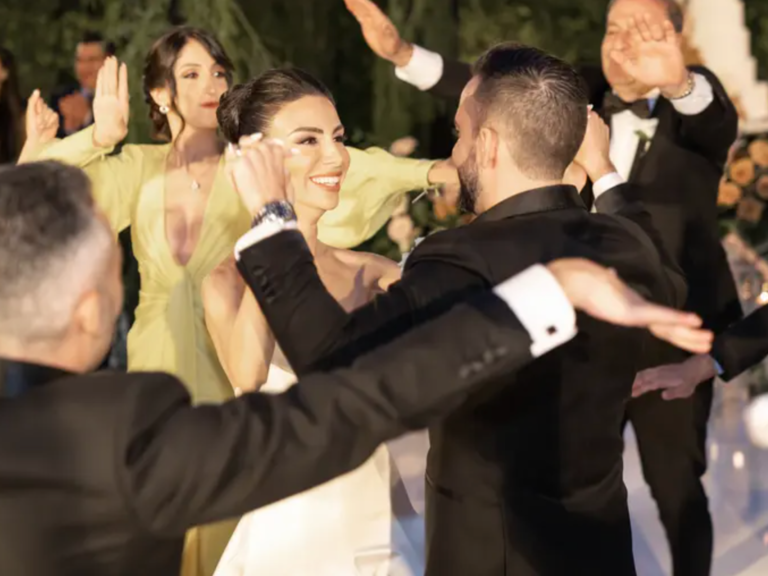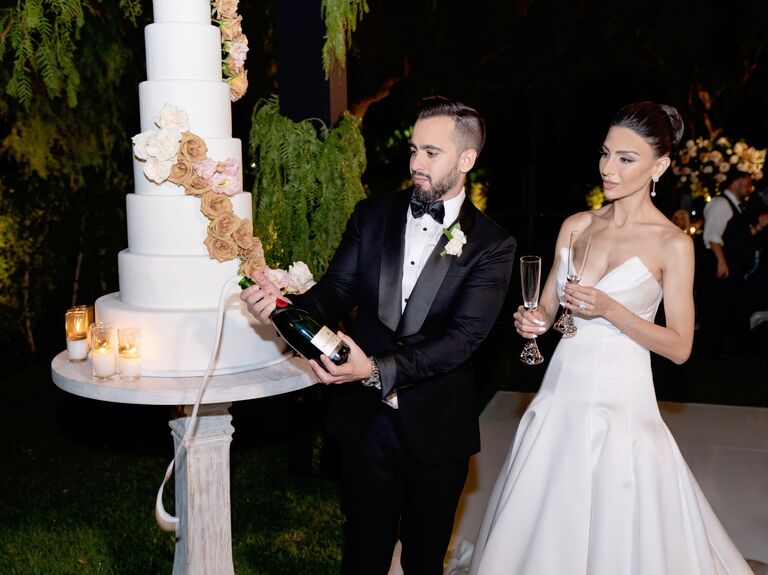Armenian Wedding Traditions Rooted in Faith and Family

Armenian wedding traditions are heavily based on faith and include loved ones in many parts of their celebration. If you're planning an Armenian wedding or attending one, it's important to understand the customs of this Southwest Asian country. Traditions include exchanging gifts between the two families, dressing in symbolic clothing, and multiple family members helping the bride get ready. As you start planning your Armenian wedding, visit The Knot Marketplace to find a planner and other vendors in your area who are familiar with wedding traditions around the world.
Hovik Harutyunyan, wedding and event planner at Harutyunyan Events in Los Angeles, California, works with couples to incorporate Armenian marriage traditions into their wedding. "Like any couple getting married these days, Armenian couples aren't restricted to supposed 'should' or 'shouldn't' rules," she said. "In this way, the new generation of Armenian couples getting married are finding their own unique ways to personalize their weddings while still celebrating their heritage and culture." From pre-wedding celebrations to after the, "I dos," incorporate a few or all of these Armenian wedding traditions into your special day.
Armenian Wedding Traditions in This Story: History | Prewedding | Attire | Ceremony | Reception | Food & Desserts | Postwedding
A Brief History of Armenian Wedding Traditions
Armenian weddings are deeply rooted in the customs and traditions of the Armenian Apostolic Church. This church still serves as the main religious institution of the country and is one of the oldest Christian churches. Historically, Armenian weddings followed conservative traditions and were often arranged. Taking place in the bride's home or the church, the wedding celebrations used to last for seven days and seven nights. Today, Armenian weddings are a one-day event but can last until the early hours of the next day.
Prewedding Armenian Traditions
From the engagement tradition to visiting the bride's home, many Armenian wedding traditions take place before the couple walks down the aisle.
Merging of Families
Armenian prewedding traditions are based on hospitality, celebration, the merging of two families and preparing the to-be-weds for their new life together. "While many known traditions, such as an engagement party and bride shower, are celebrated, Armenians also have special gatherings to introduce the families to one another as well to indicate the promise and vow for marriage," Harutyunyan said. "These gatherings are planned with catered menus, dance parties, and special gifts given by the groom's family to the bride's family - such as jewelry, clothing, chocolates, and monetary presents to celebrate the union."
The Khosk-Arnel or Khosk-Kap is an Armenian engagement tradition during which the groom and his family visit the bride's home for a formal dinner, with gifts and flowers in tow. Tea is set out and the oldest member of the groom's family asks for the bride's hand in marriage on behalf of the groom. If the oldest family member from the bride's side says yes, the families drink the tea to solidify the decision.
Bride's Home Prewedding Tradition
Taking place on the wedding day, but before the ceremony, is the tradition of visiting the bride's family home. The groom and extended family arrive in limousines to pick up the bride for the wedding. "There is usually a lot of fanfare and revelry that accompanies this processional, including dancing and performances by a trio of live dhol zurna musicians (accordion, clarinet, and drums)," Harutyunyan said. The bride's family also prepares their home for the groom's arrival, including setting up elaborate floral decorations, rentals and a catered buffet.
Family Gifts
Gifts symbolize the joining of the two families and also help to prepare the bride for the ceremony. "Upon being greeted by the bride's family, the groom's family will present richly decorated gift trays of cognac and chocolate, flowers, jewelry and the bride's shoes," Harutyunyan said. "The bride's family then invites the groom's family inside for the presentation of the bride, opening of gifts and family portraits."
Preparing the Bride Pre-Ceremony
Helping the bride prepare for the ceremony is also a family-centered Armenian wedding tradition. The bride's brother helps her put on her shoes and the maid of honor puts on the bride's perfume and veil. She is then formally brought into the living room by her father or maid of honor where she will see the groom for the first time that day. "This moment is accompanied with dancing and performances by the dhol zurna," Harutyunyan said. The families exchange gifts and the best man traditionally opens a bottle of cognac, gives a toast and serves the spirit with a tray of chocolates.
"Before the families leave for the ceremony, the bride's brother sometimes takes on extra duties, such as playfully hiding one of the bride's shoes for ransom, and blocking the exit door with a sword in his hand and only letting the couple pass once the best man has satisfyingly bribed him." The couple and wedding party then head to a different location for pre-ceremony photos.
Traditional Armenian Wedding Attire
The attire worn by the to-be-weds includes colors of red and green, and symbols of health and prosperity. This attire is steeped in Armenian tradition.
Groom Wedding Attire
"For the most part, the groom will remain in this tuxedo," Harutyunyan said. "The watch he wears is often a gift given by the bride's parents. In Iranian Armenian tradition, the groom often wears crisscrossed, colored sashes pinned to his shirt - a red sash to symbolize sacrifice and a green sash to symbolize life. The sashes are usually decorated with stitched motifs of grapes, pomegranates, and wheat - all symbols of health, prosperity, and happiness."
Bride Wedding Attire
The bride often wears a white party dress when the groom's family arrives at her house. After the pre-ceremony events she retreats to her getting-ready suite where her mother, maid of honor, bridesmaids and close female family members help her get into her formal wedding gown. Traditionally Armenian wedding dresses were red, but today most brides choose a white gown for their wedding.



"Some Armenian brides opt to wear an 'evil eye' charm as their something blue in order to protect from evil spirits or curses," Harutyunyan said. "Later in the evening, as the dance party portion of the reception begins, modern brides will change into a fun party dress."
Armenian Wedding Ceremony Traditions
Shortly after the couple's ceremony entrance, the Armenian ceremony traditions begin, including wearing crowns and sharing the common cup. An Armenian ceremony lasts about one hour.
Founded in Faith
"As the world's first Christian nation, Armenia is a country of people who are deeply proud of their faith," Harutyunyan said. "Traditionally, an Armenian wedding ceremony occurs in and follows the program of the Armenian Apostolic Church, an Eastern Christian denomination that follows in communion with other Oriental Orthodox churches…Many modern Armenian weddings these days now do ceremonies outside of the church. These ceremonies will often be officiated by a pastor or an ordained family member or friend."
The best man and maid of honor assist the priest in the program. However, Armenian wedding ceremony traditions usually don't include personal vows from the couples or readings from friends and family.
Armenian Wedding Crowns
After the vows, the couple is crowned to represent their reign over their little kingdom. The best man holds a cross over the couple's heads as they wear the ceremonial crowns. These crowns are also a symbol of glory and honor.
Common Cup Tradition
"During the ceremony, the bride and groom will also drink wine from a 'common cup' to symbolize their union with one another and with Christ," Harutyunyan said. The cup is presented by the priest or officiant. Sometimes the best man and maid of honor also take a sip from the cup as a sign of best wishes for the newlyweds.
Pillow Blessing
A common Armenian wedding blessing reads "May you grow old on one pillow." This blessing is often included in the wedding stationery and the wedding vows. It also appears on wedding favors and in reception toasts.
Showered with Coins
The newlyweds are showered with coins and bills as a wish for financial health during the marriage. Guests throw coins as the couple leaves the ceremony site. This can also take place at the reception when loved ones throw or hand money to the couple during a special dance.
Armenian Wedding Reception Traditions
Be prepared for a lot of dancing at an Armenian wedding reception. From the moment the newlyweds enter the venue to a late-night dance party, there's no shortage of celebration with this crew.
Couple Entrance
The dhol zurna musicians who performed at the bride's house earlier in the day accompany the newlyweds when they make their entrance at the reception. The couple step on a plate to break it, which symbolizes good fortune, and then head out to the dance floor. "When they get to the center of the dance floor, the live musicians will continue to surround them and all wedding guests are invited to dance as well," Harutyunyan said.
Armenian Dance Traditions
"Couples will include many of the well-known dance traditions in their reception, such as a first dance and parent dances," Harutyunyan said. "Oftentimes, the best man and maid of honor (who are typically a married couple) will also be honored by being invited to do a celebratory slow dance together." At the end of the night, Armenian traditional wedding dances including Shabash and Yarkhushta bid farewell to the happy couple.
They Know How to Party
"Armenians are known for their extensive dance celebrations so there is a lot of dancing throughout the night," Harutyunyan said. "Because the menu includes multiple main courses, the DJ will often include a full party dance set in between each course. Music genres include Armenian dance and folk music, international mixes, and top 40/house. Many couples choose to book well-known celebrity Armenian singers to perform at the reception."
Armenian Wedding Reception Length
Harutyunyan said Armenian weddings tend to be all-day affairs. Armenian receptions often last until 2 am. For this reason, they prioritize wedding venues with a late or no music curfew. From the pre-wedding events in the morning to the end of the reception the celebration can last around 17 hours.

Traditional Armenian Wedding Food and Desserts
Armenian wedding food traditions range from mezze (small dishes served as appetizers) to desserts. Armenian bread and honey are symbolic of celebrating the happy couple.
Traditional Armenian Reception Food
Armenian wedding receptions traditionally take place in a banquet hall with cuisine served family style. The menu can include mezze, main entrees and side dishes. Popular Armenian dishes include baba ghanoush, dolmas, kabob and hummus. Harutyunyan said many Armenian couples create modernized menus that still pay homage to the traditional cuisine.
Armenian Wedding Dessert and Honey
"For dessert, guests are served wedding cake, tea, and fruit stations," Harutyunyan said. "Some couples will often eat honey and don lavash - a type of Armenian bread - over their shoulder. These traditions are rooted in not only keeping away evil spirits but also celebrating the happy union of the new couple."
Armenian Postwedding Traditions
The Armenian wedding traditions continue after the wedding celebrations. This includes the end of the reception and the newlywed's first family gathering.
Staying Until the End
Traditionally there is no elaborate sendoff at an Armenian wedding. Instead, the couple stays until the final guest leaves the venue. Sometimes this means waiting until as many as 500 guests have gone home for the night.
First Dinner Party
Similar to many US couples, Armenian newlyweds head off to their honeymoon shortly after their wedding. Once they return home, they are expected to host their first dinner party as a married couple with their immediate families on the guest list. Couples may choose to serve similar dishes as their wedding day cuisine, or family recipes in their new home.





















